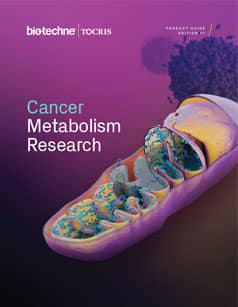Oxidative Phosphorylation
Oxidative phosphorylation is a combination of two simultaneous processes; the electron transport chain and chemiosmotic coupling. The electron transport chain (also known as the respiratory chain) comprises 4 complexes located in the inner mitochondrial membrane.
Oxidative Phosphorylation Antagonists |
|
|---|---|
| Cat. No. | Product Name / Activity |
| 8070 | DX3-213B |
| Potent NDUFS7 antagonist | |
Oxidative Phosphorylation Inhibitors |
|
| Cat. No. | Product Name / Activity |
| 2864 | Metformin hydrochloride |
| Mitochondrial complex I inhibitor; also activates LKB1/AMPK | |
| 4979 | Methylmalonate |
| Succinate dehydrogenase inhibitor | |
| 3616 | Rotenone |
| Inhibits complex I of the mitochondrial electron transport chain | |
Oxidative Phosphorylation Activators |
|
| Cat. No. | Product Name / Activity |
| 0223 | Kynurenic acid |
| Promotes ATP synthase dimerization, offers ischemic protection. | |
Other |
|
| Cat. No. | Product Name / Activity |
| 5737 | BAM 15 |
| Mitochondrial protonophore uncoupler | |
| 0452 | CCCP |
| Oxidative phosphorylation uncoupler | |
| 0453 | FCCP |
| Oxidative phosphorylation uncoupler | |
| 4245 | Meclizine dihydrochloride |
| Reduces mitochondrial respiration and increases glycolysis; neuroprotectant; also PXR agonist | |
Oxidative phosphorylation is a combination of two simultaneous processes; the electron transport chain and chemiosmotic coupling. The electron transport chain (also known as the respiratory chain) comprises 4 complexes located in the inner mitochondrial membrane. NADH and FADH2, produced from glycolysis and the Krebs cycle, release electrons at certain points in the chain, which are passed from one electron acceptor to the next. Each time an electron is passed from one complex to the next, it loses energy.
Chemiosmotic coupling harnesses the energy from the electron transport chain and uses it to transport H+ across the inner mitochondrial membrane, establishing a concentration gradient. ATP synthase is found in the inner mitochondrial membrane and this enzyme uses the energy from H+ ion flux to synthesize ATP. Three ATP molecules can be made from each pair of electrons from NADH and two ATP molecules are made from a pair of electrons from FADH2.
Literature for Oxidative Phosphorylation
Tocris offers the following scientific literature for Oxidative Phosphorylation to showcase our products. We invite you to request* your copy today!
*Please note that Tocris will only send literature to established scientific business / institute addresses.
Cancer Metabolism Research Product Guide
This product guide reviews some of the main areas in cancer metabolism research and lists around 150 products that can be used to investigate metabolic pathways in cancer including:
- Glycolysis
- Tricarboxylic Acid Cycle
- Lipidogenesis
- 1C Metabolism and Nucleic Acid Synthesis
- Drivers of Metabolic Reprogramming
- pH and Redox Balance
